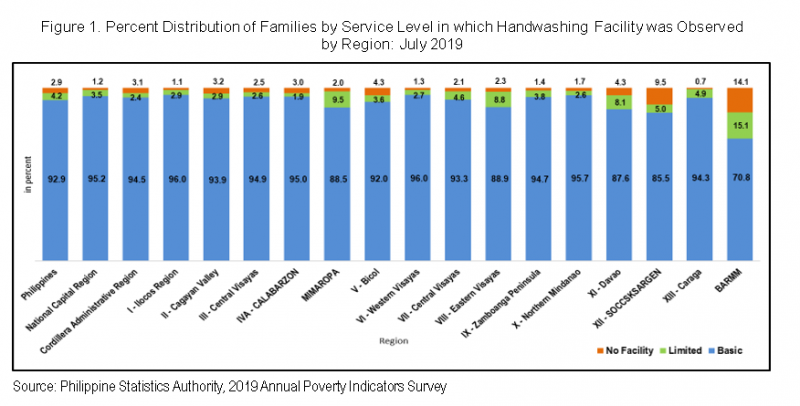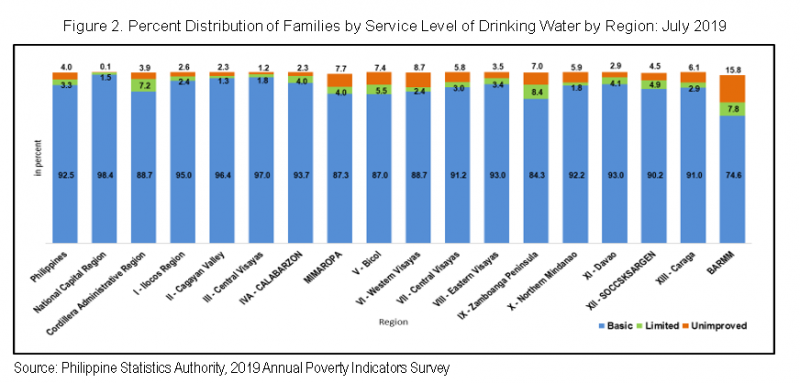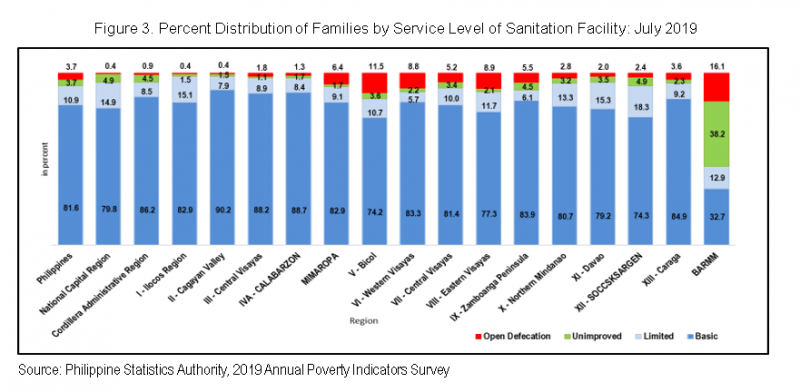Four out of Five Children Aged 5 to 24 Years Were Attending School for School Year 2022 to 2023
The 2019 Annual Poverty Indicators Survey (APIS) included questions related to the provision of adequate drinking water, sanitation, and hygiene (WASH) facilities similar to its first introduction in the 2017 APIS. The inclusion of WASH was primarily done to monitor the Sustainable Development Goal (SDG) national indicators. This report presents the WASH indicators based on the results of the 2019 APIS.
Hand Washing
Majority (93.7 percent) of the 25 million Filipino families had a hand washing facility, mainly in the form of fixed facility (sink/tap) in the dwelling unit (69.9 percent), majority of which had available water (96.6 percent), and with provision of bar/liquid soap (82.9 percent) and/or detergent soap (43.0 percent) for hand washing. (Table 1a)
In 2019, most families (92.9 percent) had access to Basic service level handwashing facilities or handwashing facilities on premises with soap and water. This was a significant increase from 76.9 percent in 2017. (Table 1b)
Urban areas had a higher proportion (93.9 percent) of families with access to Basic handwashing facility compared to rural areas (91.8 percent). (Table 1b)
Across regions, families in Bangsamoro Autonomous Region in Muslim Mindanao (BARMM) had the highest share of handwashing facility with limited service (15.1 percent), and without hand washing facility (14.1 percent). (Table 1b, and Figure 1)

Drinking Water
Results of the 2019 APIS showed that majority (95.8 percent) of families had an improved source of drinking water, mostly of which were water refilling stations (45.2 percent), and water piped into dwelling unit (20.4 percent). Coverage of families with improved drinking water sources in urban areas (98.1 percent) was slightly higher compared to rural areas (93.4 percent).
On the sufficiency of drinking water, majority (85.2 percent) of families reported that drinking water was sufficient. However, four in every five families (78.8 percent) did not practice any method or treatment in ensuring their drinking water is safe to drink. (Table 2a)
About nine in every ten families (92.5 percent) had at least Basic service level drinking water or those from improved source and roundtrip collection time is not more than 30 minutes, which has significantly increased from the proportion of families that reported the same service level in 2017 (90.8 percent).
Across regions, BARMM (74.6 percent) had the lowest proportion of families with access to basic drinking water services, followed by Zamboanga Peninsula (84.3 percent) and Bicol region (87.0 percent). (Table 2b, and Figure 2)

Sanitation
In 2019 APIS, about 81.6 percent of families had an improved sanitation facility not shared with another household, while about 10.9 percent had an improved sanitation facility but shared1. Only 3.7 percent had an unimproved sanitation level service. (Table 3a)
About four in every five families (81.6%) had Basic service level sanitation or the use of improved facilities that are not shared with other households, with coverage in 2019, significantly higher than the 73.7 percent in 2017. (Table 3b)
By region, the proportion of families using Basic sanitation level services ranged from 32.7 percent in BARMM to 90.2 percent in the Cagayan Valley. The top three regions with the highest percentage of families with no toilet facility or still practicing open defecation were BARMM (16.1 percent), Bicol (11.5 percent), and Eastern Visayas (8.9 percent). (Table 3b, and Figure 3)

DENNIS S. MAPA, Ph.D.
Undersecretary
National Statistician and Civil Registrar General
1 Shared with two or more households
